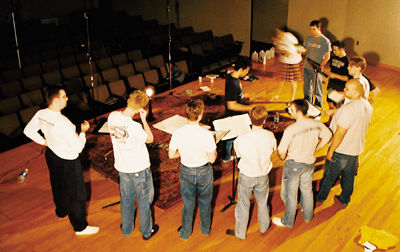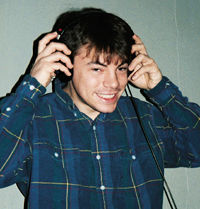| Columns Retired Columns & Blogs |
One by One: the Cantus Recording Project Page 2
The Concert Hall is intimate, seating around 500, and is decidedly "modern"—all flat planes and glass surfaces, complete with a 55-rank organ and a reflective "cloud" suspended over the audience to focus the sound, which is bright and immediate. John's first task was to find microphone placements that made the most of the hall's reverberant cushion without emphasizing its unforgiving nature. A neat trick, and one I can blithely skip over—it wasn't my problem. Ditto the fan noise, which, in the spring-break silence, was wreaking havoc on our recording session from several buildings away.

Now numbering 12, Cantus had prepared a daunting 18-song program encompassing 11 of the songs John and I had first heard that misty October evening, plus seven other challenging pieces, including a collection of Inuit songs, a Georgian wedding song, and the solemn-sounding but mischievous "Domaredansen."
Oh gentle daughters, here come the wooing men.
O gentle daughters, put the wheels in motion for me.—"Dúlamán"
"This CD is our celebration of world music," said Erick Lichte. "We didn't want to simply make a folk-song collection that turned 'Loch Lomond' and 'Danny Boy' into the sorts of pretty songs people think of as 'choral music.' We wanted to go deeper into different cultures and types of music that would not normally be included on 'choral' CDs. We dived into Russian choral music with 'Shen Khar Venakhi,' and we definitely explore a different timbre on that piece. And then there's 'Nukapianguaq,' the Inuit chants, which are not so much arrangements as they are a suite of the chants themselves.
"So many choral folksong collections give a washed-out impression of what world music actually is. We wanted to avoid that. We listened to native groups who had performed these pieces and we learned how to adapt our style to the music. It seem obvious, but I can't really stress enough that we simply cannot perform 'Nukapianguaq' the same way we perform an Irish song like 'She Moved Through the Fair.' It doesn't work musically—or linguistically."
 Tim Takach, another bass, added, "This album is different from a typical choral collection of folk songs, because we're different. We created the group specifically to explore the differences—and the similarities, too—of all the various types of choral music we encountered. We wanted to experience these differences rather than just explore our sound."
Tim Takach, another bass, added, "This album is different from a typical choral collection of folk songs, because we're different. We created the group specifically to explore the differences—and the similarities, too—of all the various types of choral music we encountered. We wanted to experience these differences rather than just explore our sound."
That's not to say that Cantus shies away from exploring its individual strengths. Michael Hanawalt, one of the group's tenors, explained: "One special aspect to the more familiar songs we perform is that they have been arranged by members of the group for the group. For instance, Erick arranged 'Danny Boy,' I arranged 'Loch Lomond,' and Tim arranged 'She Moved Through the Fair,' tailoring the arrangements perfectly to the individual voices in the group. No other group could really sing them—they simply wouldn't fit."
"Absolutely," said Lichte. "I wrote 'Danny Boy' 's arrangement with an incredibly difficult tenor solo obbligato line specifically for Brian Arreola. It's unbelievably high, but I wrote it with his abilities—and even his personality—in mind. The whole package of the performers is included in some of these arrangements. I think you can hear it on the recording."
I think so, too. I've heard many impressive choral CDs, but Let Your Voice Be Heard's canny blend of unusual and familiar repertory—with the familiar sounding as new as the songs we've never heard—combined with the passion and purity of these young men's voices, puts the disc among the truly special few. Cantus' unique synergy permeates the disc, elevating it from a successful program to a compelling one.
You are a vine and blossom.
You are a fragrant plant in Eden.
You are a fragrant poplar in paradise.
You have no equal.
You are a shining sun.—"Shen Khar Venakhi"
In Northfield, the group buckled down to work immediately and maintained a crippling pace. While John Atkinson and fellow music-lover Jim Johnson, an AT&T research scientist exploring surround-sound models for music, set up their microphone arrays, the group began practicing and acquainting themselves with the hall's acoustic. As we began recording, the majority of the group would remain on stage after we completed takes, discussing performance strategies, while chosen "producers" ran backstage to critique the playback.
Erick Lichte explained, "Because we operate as a collaborative group, it's essential that we all be involved in the process all the way through. The problem with that is that getting 12 people to do anything is a very difficult task, so we try to incorporate people individually in different songs—and we have enough trust in one another musically that if one of us says something's good enough, we know it's good, and if he says do it again, we'll do it again."
"This process was a lot more intentional than our last two discs," Michael Hanawalt said. "A lot more thought went into this recording. Everything was structured to get the best out of us. It's a streamlined process—and it helped us get the recording done in the short time we had to do it.
"While we operate as a chamber ensemble, within that context we operate as a chamber ensemble made up of a group of friends. We enjoy making music together; we enjoy spending time with one another. That allows something to happen in the music that takes it to a different level than a group of strangers—and I think that particularly comes through in this recording."
- Log in or register to post comments




































